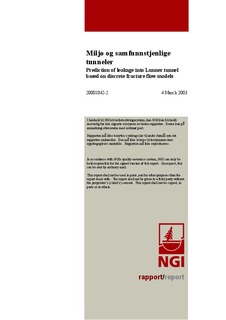| dc.description.abstract | As part of the project “Tunnels for the citizen”, sub-project B “Environmental
concerns”, coordinated by the Norwegian Road Authority (“Statens
vegvesen”), a discrete fracture network model was used to investigate the
hydrogeological conditions before and after construction of the Lunner tunnel.
A limited model was considered which covers an area of 550 m x 550 m
comprising the transition zone from two rock types (hornfels and syenite)
where potential problems were foreseen. Available data from site investigation
performed by Statens vegvesen and NGU was used to build the model. First,
large scale features which could be geologically mapped were represented
deterministically. Smaller scale features which could only be characterised in a
statistical sense from boreholes observation in terms of orientation, dip, length,
density were used to stochastically generate discrete fracture networks through
which water flows. Saturated transient and steady state calculations were
performed to predict the amount of leakage into the tunnel during construction.
Only linear groundwater flow was considered, with a constant recharge from
precipitation. Due to the uncertainty related to crucial input parameters such as
fracture length and fracture hydraulic properties, a parametric analysis was
carried out to investigate the range of variation in the model predictions.
The results from the modelling give a three dimensional picture of the
groundwater level after tunnel excavation. They outline the interrelation
between tunnel and main conductive faults in the establishment of a lowered
water table. Due to tunnel excavation, a rapid drawdown is established above
the tunnel and propagates into the rock mass along conductive fault zones.
Injection of the faulted zone contributes to a drastic reduction in leakage rates
in the whole tunnel, although locally the water inflow increased on both sides
of the injection interval through secondary fracture sets.
The work presented in this report contributed to:
• assess the capabilities of discrete fracture network models generally,
and more specifically their application to modelling of groundwater
flow around tunnels in fractured rock masses
• test the commercial software Napsac used for the purpose of the
analyses
• carry out a blind prediction of the effect associated with tunnel
excavation in a potentially sensitive area, based on data collected
during pre-investigation work
• evaluate the results from discrete fracture modelling and the sensitivity
to input parameters. Of particular interest were the correlations between
tunnel leakage, pore pressure changes and groundwater drawdown,
which could be used to define acceptance criteria for tunnel leakage
based on the vulnerability of vegetation and water sources. | no_NO |
